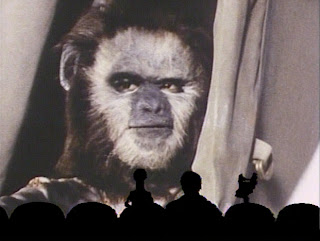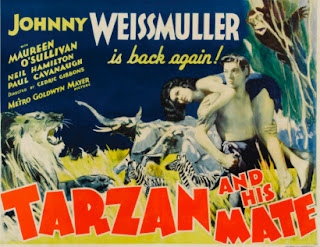Summary:
It’s a happy morning for two
school children Johnny (Masaaki Kaji) and Caroline (Hiroko Saito). They are
going to visit their uncle’s top-secret laboratory and learn about his project
dealing with cryogenics. Assistant Catherine (Reiko Tokunaga) shows the kids
around the laboratory, finally stopping in the room with the freezing pods.
Wouldn’t you know it, the local volcano erupts and sends the three into the
pods as the only safe place. Quicker than you can say Popsicle, they are frozen
and awake to find themselves in a world where Apes have evolved into men!
They escape a laboratory and
make for Green Mountain, where they encounter a lone human named Godo (Tetsuya
Ushio) who decides to help them. Along the way they meet the helpful ape child
Pepe (Kazue Takita) and attempt to escape the evil Chief Gebar (Baku
Hatakeyama). What follows are chases, escapes, deception, double crosses, a
flying saucer and a startling revelation that could change everything. Will
Johnny, Caroline and Catherine ever escape from the Time of the Apes?
Movie Review:
 |
| Chief Gebar pretends he's General Patton. |
When it comes to science
fiction movie milestones there are always a certain set of films that get
mentioned. One of those is Planet of the Apes, the film that pitted Charleton Heston against gun toting ape-men. Of
course there was a whole lot more going on in it, including some social
commentary that helped turn the first film into a classic (the sequels… not so
much). It’s not hard to imagine that this film inspired moviemakers across the
globe. This is one of those “inspired” films.
Well let’s back up a bit.
This is another one of those “movies” that is really a severely edited version
of a television show. The series was called Saru no Gundan translated to “Army of the Apes” which actually fits
the film pretty well. This series ran for 26 episodes each about 30 minutes
long. That means a story that ran for 780 minutes is condensed down to roughly
97 minutes of a “movie”. The end result just barely manages to make any sense
at all.
Yes, Time of the Apes was brought to us by Sandy Frank - the same
gentleman who brought us Fugitive Alien and
the Gamera translations. On the one
hand you want to thank him for exposing us to some classic Japanese films and
series. On the other, you wonder if the hack job on these was worth it. With so
much editing, chopping and jumping around, the movie plays like a fever dream
of endless chases and escapes. You loose track of why the characters are doing
anything, and just sit there thinking, “Well it’s all going to make sense in
the end, right?” And in some warped surreal way it does all make sense. But it
requires the logical mind to shut down and bask in the ape fantasy that abounds
in front of you.
 |
| Caroline, Johnny and Catherine awake to an ape filled time. |
Visually Time of the Apes looks like what you’d
expect from a television series from the 1970s with a limited budget attempting
to mimic Planet of the Apes. Most of
the ape-men end up looking pretty hilarious in masks that don’t flex of bend
correctly for speaking purposes. There’s lots of ridiculous pantomime combined
with some hilarious outfits. Some of the apes are dressed like Japanese humans
of the 1970s. So Pepe is running around in jeans and sneakers, while Chief
Gebar appears to be modeled after General Patton. Then there are the apes wearing
elaborate fop outfits, or dressed like Colonel Sanders.
The style of the film is
also typical of the period. You get lots of crazy editing, rapid-fire zooms and
frantic action scenes. It keeps things exciting, sure, but it also adds to the
confusion. If anything, the film seems a bit ahead of its time with the speed
at which it moves. It’s hard to tell if this was part of the production in 1974
or the editing job in 1987.
Mostly the dubbing is pretty
god awful, but in truth you only really notice it when the humans are speaking.
The ape masks are so poor that no matter what language they are speaking, the
dubbing would look off. Those mouths barely move. The dub voice actors are
mostly of the over the top variety, with Chief Gebar chewing the audio scenery.
The gasping and moaning sounds as perverse as it normally does, but that is
expected in dubs from this era.
 |
| Pepe: ape-boy, ape-girl or owl? |
I did like the zesty peppy
music used in Time of the Apes.
There’s some cool 70s guitar work in there as well as some very prog sounding synths.
Although some of it was tracked very poorly. Peppy music is synched to dramatic
or tense scenes and vice versa. This happened in Fugitive Alien as well, so I suspect that this may have been a side
effect of the poor dubbing job. But then again, who knows for sure.
Also difficult to judge is
the acting in general. You can tell this is a show aimed at kids, so things are
played pretty broadly. The pantomiming apes and overly expressive children can
be ridiculous at times. And combined with the poor dubbing it is just a
hilarious mess.
Even without Mystery Science
Theater on board, this movie would be a blast to watch. It moves quickly, is
filled to bursting with odd visuals and has plenty of action, running and
hiding to keep you interested. As long as you don’t try to figure out what is
going on, a viewer has a prime riffing feature to enjoy. But why not let Joel
and the bots to the heavy lifting here.
Episode Review:
 |
| Godo attempts to protect the only other humans |
Season three of the series
was known for it’s Japanese films and the great riffing they got. Time of the Apes is really one of my
favorites. I think I enjoy Fugitive
Alien a tiny bit more, but only because the story makes a tiny bit more
sense.
This movie was actually
riffed on twice by the crew. The first time was during the KTMA run of the
show. Everyone remembered how much fun they had with the show, so they asked Comedy
Central to get the rights. They tackled this one fairly early in the season and
really seemed to be firing on all cylinders.
Everything is game for them,
from the hilarious dubbing and editing, to the costumes and odd plot
contrivances. Katherine, Johnny and Caroline do a lot of ducking into hallways
and hiding and alcoves. The ape troops walk right by and never see them. After
a while Joel wonders “Doesn’t anyone have peripheral vision in this movies?”
 |
| Chief Gebar wants you to make his day. |
They also work “monkey” and
“ape” into many of the riffs turning this into a very punny episode. On a quick
zoom up to Godo as he aims a gun at the ape troops Tom says, “Steven Segal in
‘Shock the Monkey’”. Or when a
guard is knocked senseless by Godo in a later scene Crow quips, “It’s bed time
for Bonzo.” There’s also an entire bevy of poop flinging jokes. One of my
favorites is as the ape president drives up to his headquarters; there are a
whole mess of soldiers out front that snap to attention. Tom wonders if they
will offer a 21-crap salute.
Early in Time of the Apes when Johnny’s mother
worries about the minor tremor might lead to a bigger quake, she whines and
asks Johnny not to go to the lab with Caroline. Johnny turns to his mother and
is dubbed in a perky peppy way saying, “I don’t care!” This inspires endless
running jokes offering Johnny plenty of things he should care about, or having
him answer “I don’t care” to just about anything. I love when Johnny triggers a
trap on Green Mountain and is about to be skewered. Joel says, “I bet you care
now!”
Really that’s only the tip
of the iceberg. This episode is packed with classic riffing. One of my favorite
sequences is a single minute of zooms, gasps, moans and more zooms. The boys
riff this perfectly. I wasn’t able to find just that scene, but watch the first
minute of the clip below to see that sequence. It’s easily one of the
highlights of season 3.
 |
| Crow is supposed be Spencer Tracy as Clarence Darrow. |
The host segments are pretty
fun. Things start off with Joel and the bots attempting to play some baseball.
But it all goes wrong when they break and window and create a hull breach. For
the invention exchange, Joel creates the cellulite phone. This pink phone
expands as you order take out to remind you to stay on your diet. The mad
scientists create the Miracle Grow Baby Formula that will grow your baby faster
in less time. It works too well. At the first break, Joel and bots present a
short film about why Johnny doesn’t care. It’s gets pretty dark actually. The
next break goes silly, as Joel and the bots attempt to recreate the Scopes
Monkey Trial from Inherit the Wind. A
standee of Judge Wapner is a special guest. The fashions of the apes inspire
Crow to present spring fashions based on the film. It’s pretty hilarious stuff.
When the film ends, Joel and the bots sing a song based on the music of the end
credits. It describes about how “Sandy Frank is the source of our pain”.
Time of the Apes is one of the best episodes of Season three and well worth seeking out.
The fast paced movie, combined with some excellent riffing and fun host
segments make this one of my favorite episodes from the Comedy Central years.
I give it five ape filled
zooms out of five.
This episode is available on Mystery Science Theater 3000: Volume XXII.


























